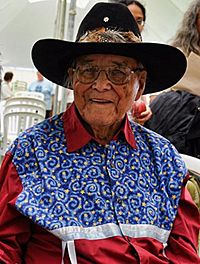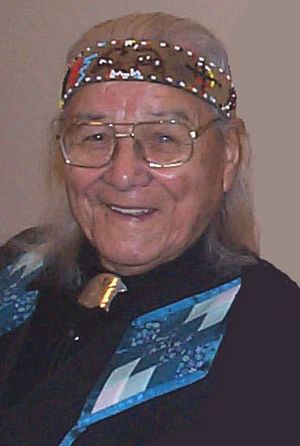William Commanda facts for kids
Quick facts for kids
William Commanda
|
|
|---|---|

William Commanda (by Carol Noel)
|
|
| Born | November 11, 1913 |
| Died | August 3, 2011 (aged 97) |
| Known for | Spiritual leader; band chief 1951–1970; promoter of environmental stewardship |
| Title | Officer of the Order of Canada |
William Commanda OC (born November 11, 1913 – died August 3, 2011) was an Algonquin elder and spiritual leader. His Algonquin name was Ojigkwanong, which means "Morning Star." He was known for promoting care for the environment.
Commanda was the Band Chief of the Kitigàn-zìbì Anishinàbeg First Nation near Maniwaki, Quebec, from 1951 to 1970. During his life, he worked as a guide, trapper, and woodsman. He was also a very skilled artist who made beautiful birch bark canoes. He was the Keeper of several special wampum shell belts. These belts held important records of prophecies, history, and agreements. In 2008, Commanda was given a high honor: he was made an Officer of the Order of Canada.
Contents
Early Life of William Commanda
William Commanda was born on November 11, 1913, in what was then called River Desert Indian Reserve. This place is now known as Kitigàn-Zìbì. His parents were Alonzo and Marie Commanda. His Algonquin name, Ojigkwanong, came from a special moment. His mother looked out their log cabin window and saw the morning star shining brightly.
William Commanda had important family members before him. His grandfather was Chief Louizon Commanda. His great-grandfather was Chief Pakinawatik. In 1854, Chief Pakinawatik led his people from Oka, Quebec to Kitigàn-zìbì. William was baptized in a Catholic church just eight days after he was born.
Growing up, William's family faced many challenges and poverty. Sometimes, he even hid in the bush to avoid going to the Canadian Indian residential school system. His family often struggled to find enough food. To earn money, William became a master at making canoes from birch bark. He also worked in lumber camps. His health, which had been weak from his difficult childhood, started to get better in 1961.
Becoming a Chief and Leader
From 1951 to 1970, William Commanda served as the Band Chief for the Kitigàn-zìbì Anishinàbeg First Nation. In 1970, his community gave him three sacred wampum belts. These belts were very old and important historical records. The three Wampum Belts he cared for were:
- The Seven Fires Prophecy Belt: This belt is seen as a founding document for the Algonquin Nation.
- The Jay Treaty Border Crossing Belt: This one relates to agreements about crossing borders.
- The Three Figure Welcoming/Agreement Wampum Belt: This belt represents welcoming and agreements.
William Commanda built canoes at Expo 67, a big world's fair. In 1969, he started the first Circle of All Nations. This was a gathering meant to bring back Aboriginal culture and spirituality. He invited people to his home every August for a meeting. The goal was to build good relationships between different nations, promote healing and peace, and protect the Earth. This meeting still happens every year and includes people who care about the environment.
Later Years and Achievements
Even though William Commanda was married and never had his own children, people respectfully called him "Grandfather." In his later years, he received many honors. He continued to be a spiritual leader for his people. He also worked hard for peace, the rights of Indigenous peoples, and caring for the environment.
He received the key to the city of Ottawa. He also got an honorary doctorate degree from the University of Ottawa. He won a lifetime achievement award from the National Aboriginal Achievement Awards Foundation. Commanda also took part in events at the United Nations. He organized international meetings for elders and world leaders. He even led peace pipe ceremonies for the Rio Earth Summit in 1991.
In 1987, he was asked to build a canoe for Queen Margrethe of Denmark. Also in 1987, he started teaching about the messages of the wampum belts. This was at a big meeting about Aboriginal rights and self-government. In 1990, he was invited to give a traditional blessing at the Canadian Human Rights Monument in Ottawa. He did this alongside the Dalai Lama.
In 1998, Commanda took part in a special ceremony. He gave Nelson Mandela an eagle feather on behalf of Canada's First Nations. That same year, Commanda organized "Elders Without Borders." This was a gathering of Aboriginal Elders and spiritual leaders from North and South America. He also received The Wolf Award for his work in helping different cultures understand each other and promoting peace between races.
In 2008, Commanda was made an Officer of the Order of Canada. He kept working until his last days to protect important natural places. These included Chaudière Falls at Victoria Island in Ottawa, and the South March Highlands in Kanata. He strongly believed that Chaudière Falls should be returned to its natural state, free from concrete.
He celebrated his 96th birthday with Prince Charles at Rideau Hall. He opened the dinner with a First Nations prayer. About 150 guests were there, and afterward, a potluck was held at Commanda's home.
Death and Lasting Impact
William Commanda had been unwell with kidney problems before he passed away. He died early on the morning of August 3, 2011, at his home on the Kitigàn-zìbì reserve. After his death, many Indigenous leaders and others praised his work and what he left behind.
They said he was a strong supporter of his people's rights. He also worked for many years to help Indigenous and non-Indigenous people get along. He became a role model, especially for young people who were struggling. He also helped those seeking guidance after their experiences with residential schools. He organized important meetings for Elders and world leaders.
Assembly of First Nations National Chief Shawn A-in-chut Atleo said that Commanda was "a truly unique and exceptional man." He added that Commanda "dedicated his life to building bridges between people of all nations and all generations." Marlene Jerome, the Vice Grand Chief of the Algonquin Nation Tribal Council, said that "A page of our history has closed with William Commanda." But she added that "Algonquin people will have an everlasting memory of a great man."
In 2021, a train bridge between Ottawa, Ontario, and Gatineau, Quebec, was renamed the Chief William Commanda Bridge. This was part of a project to turn the bridge into a path for walking and cycling.
The University of Ottawa has a building named after him. The Institute of Canadian and Aboriginal Studies is now called the William Commanda Building. William Commanda never had any children of his own. His wife, Mary, passed away in the late 1980s. However, they adopted Mary's niece, Evelyn Derache-Commanda, and her son, Sonny Smith-Commanda.


